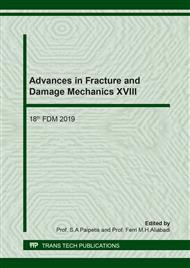[1]
Xu, X. P., Needleman, A., (1993). Void nucleation by inclusion debonding in a crystal matrix. Modell. Sim. Mater. Sci. Eng. Vol. 2, pp.417-418.
Google Scholar
[2]
Alfano, G., Sacco, E., 2006. Combining interface damage and friction in a cohesive-zone model. Int. J. Num. Meth. Eng. Vol. 68 (5), pp.542-582.
DOI: 10.1002/nme.1728
Google Scholar
[3]
Parrinello, F., Failla, B., Borino, G., (2009). Cohesive-frictional interface constitutive model. Int. J. Solids Structures Vol. 46 (13), pp.2680-2692.
DOI: 10.1016/j.ijsolstr.2009.02.016
Google Scholar
[4]
Parrinello, F., Marannano, G., Borino, G., Pasta, A., (2013). Frictional effect in mode II delamination: Experimental test and numerical sim.. Eng.Fract.Mech. Vol.110, pp.258-269.
DOI: 10.1016/j.engfracmech.2013.08.005
Google Scholar
[5]
Parrinello, F., Marannano, G., Borino, G., (2016). A thermodynamically consistent cohesive-frictional interface model for mixed mode delamination. Eng.Frac.Mech. Vol. 153, pp.61-79.
DOI: 10.1016/j.engfracmech.2015.12.001
Google Scholar
[6]
Parrinello, F., Borino, G., (2019). Non associative damage interface model for mixed mode delamination and frictional contact. E.Jour.Mech.A/Sol. Vol.76 pp.108-122.
DOI: 10.1016/j.euromechsol.2019.03.012
Google Scholar
[7]
Parrinello, F., Borino, G., (2018). Integration of finite displacement interface element in reference and current configurations. Meccanica Vol. 53 (6), pp.1455-1468.
DOI: 10.1007/s11012-017-0804-0
Google Scholar
[8]
Parrinello, F., Marannano, G., (2018). Cohesive delamination and frictional contact on joining surface via XFEM. AIMS Materials Science Vol. 5 (1), pp.127-144.
DOI: 10.3934/matersci.2018.1.127
Google Scholar
[9]
Parrinello, F., (2018). Analytical solution of the 4ENF test with interlaminar frictional effects and evaluation of mode II delamination toughness. Jour. of Eng.Mechanics Vol. 144 (4).
DOI: 10.1061/(asce)em.1943-7889.0001433
Google Scholar
[10]
Lorenz, E. (2008) A mixed interface finite element for CZM. CMAME Vol. 198, p.302–317.
Google Scholar
[11]
Gulizzi, V., Rycroft, C., Benedetti, I., (2018). Modelling intergranular and transgranular micro-cracking in polycrystalline materials. CMAME Vol. 329, pp.168-194.
DOI: 10.1016/j.cma.2017.10.005
Google Scholar
[12]
Benedetti, I., V.Gulizzi, A.Milazzo. Grain-boundary modelling of hydrogen assisted intergranular stress corrosion cracking. Mechanics of Materials Vol. 117 (2018): pp.137-151.
DOI: 10.1016/j.mechmat.2017.11.001
Google Scholar
[13]
Benedetti, Ivano, Vincenzo Gulizzi. A grain-scale model for high-cycle fatigue degradation in polycrystalline materials." International Journal of Fatigue 116 (2018): 90-105.
DOI: 10.1016/j.ijfatigue.2018.06.010
Google Scholar
[14]
Gulizzi,V., A.Milazzo, I.Benedetti. (2015) An enhanced grain-boundary framework for computational homogenization and micro-cracking sim.. Comp.Mech. Vol.56.4: pp.631-651.
DOI: 10.1007/s00466-015-1192-8
Google Scholar
[15]
Mergheim, J., Kuhl, E., Steinmann, P., (2004). A hybrid discontinuous galerkin/interface method for the comput. modelling of failure. Com.Num. Met. Eng. Vol.20 (7), pp.511-519.
DOI: 10.1002/cnm.689
Google Scholar
[16]
Vinh Phu Nguyen, (2014) Discontinuous Galerkin/extrinsic cohesive zone modeling: Implem-entation caveats and applications in comput. Frac. mech.. Eng.Frac.Mech. Vol.128, p.37–68.
DOI: 10.1016/j.engfracmech.2014.07.003
Google Scholar
[17]
de Veubeke, F., (1964). Upper and lower bounds in m.s.a. AGARDograf Vol.72, pp.165-201.
Google Scholar
[18]
de Veubeke B.F., (1965). Stress Analysis. Zienkiewicz, Holister, Cp.9. Wiley: London.
Google Scholar
[19]
De Almeida J.P.M., P. O., (2006). Upper bounds of the error in local quantities using equilibrated and compatible fin. elem.. CMAME. Vol.195, pp.279-296.
DOI: 10.1016/j.cma.2004.09.012
Google Scholar
[20]
M. Kempeneers, J. D., Beckers, P., (2010). Pure equilibrium tetrahedral finite elements for global error estimation by dual analysis. Int. J. Numer. Meth. Engng Vol.81, pp.513-536.
DOI: 10.1002/nme.2703
Google Scholar
[21]
Parrinello F., (2013) Restraining approach for the spurious kinematic modes in hybrid equilibrium element. Comput. Mech. Vol.52: p.885–901.
DOI: 10.1007/s00466-013-0851-x
Google Scholar
[22]
Borino, G., Fratini, L., Parrinello, F., (2009). Mode I failure modelling of friction stir welding joints. Intern. Journal of Adv. Manufact. Technology, Vol.41 (5-6), pp.498-503.
DOI: 10.1007/s00170-008-1498-1
Google Scholar
[23]
F. Parrinello, I. Benedetti, G., Borino. (2018) A thermodynamically consistent CZM for low-cycle fatigue analysis. Key Engineering Materials, Vol.774; pp.576-582.
DOI: 10.4028/www.scientific.net/kem.774.576
Google Scholar
[24]
Marannano, G., Pasta, A., Parrinello, F., Giallanza, A. (2015) Effect of the indentation process on fatigue life of drilled specimens. Jou. Mech.Sci.Tech. Vol.29 (7): pp.2847-2856.
DOI: 10.1007/s12206-015-0613-0
Google Scholar


